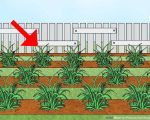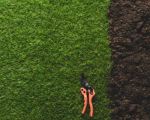Understanding Why Lawns Dry Out
As a homeowner, there’s nothing more frustrating than seeing your beautiful lawn turn brown and crispy during the warmer months. If you’re asking yourself, “How do I keep my lawn from drying out?” you’re not alone. It’s a common issue that many people face, especially in areas with hot and dry climates. Understanding the reasons why lawns dry out is the first step in preventing it.
There are several factors that contribute to a lawn’s vulnerability to drying out, and most of them are related to water management. When your lawn doesn’t receive enough water or is exposed to excessive heat, the grass starts to struggle. In some cases, poor soil quality and improper lawn care practices can exacerbate the problem.
The Importance of Proper Watering
The most important factor in preventing your lawn from drying out is water. Proper watering techniques are crucial for maintaining healthy grass. Too little water leads to dehydration, while too much water can drown the roots, creating a breeding ground for diseases.
To ensure your lawn gets the water it needs, it’s essential to know how much water it requires. The general rule of thumb is to water your lawn deeply but infrequently, aiming for about 1 to 1.5 inches of water per week, including rainfall. This encourages the grass to develop deep roots, which helps it survive during dry spells.
When to Water Your Lawn
Timing is everything when it comes to watering your lawn. Watering during the hottest part of the day, typically between 10 a.m. and 4 p.m., can lead to rapid evaporation, meaning your lawn won’t absorb the water efficiently. The best time to water is early in the morning, just after dawn, or late in the evening when temperatures are cooler.
By watering at these times, you’ll allow the water to soak deep into the soil and give the grass a chance to absorb it before the sun heats up. Early morning watering also helps prevent fungal growth, which can develop in damp conditions when water is left sitting on the grass overnight.
Soil Health and Lawn Aeration
Another important factor in keeping your lawn from drying out is maintaining healthy soil. Soil that is compacted can make it difficult for water and nutrients to reach the roots. This can result in shallow root systems that struggle to absorb water efficiently, especially during dry periods.
Lawn aeration is a technique that involves creating small holes in the soil to allow better air and water penetration. It’s recommended to aerate your lawn once a year, preferably during the growing season. Aeration helps improve soil structure, reduces compaction, and promotes deeper root growth, ultimately helping your grass stay healthy and hydrated.
Using Mulch to Retain Moisture
Mulching is a fantastic way to keep your lawn from drying out. Applying a layer of mulch, whether it’s grass clippings, wood chips, or organic matter, helps retain moisture in the soil by reducing evaporation. Mulch also provides nutrients as it decomposes, enriching the soil and improving its ability to hold water.
When applying mulch, ensure it’s spread evenly over the surface of your lawn, avoiding a thick layer that could smother the grass. A thin, even layer of mulch helps protect the soil and keeps moisture levels consistent. Just be careful not to cover the crowns of the grass, as this can hinder growth.
Choosing the Right Grass for Your Climate
If you live in an area with frequent dry spells, it’s essential to choose a grass type that can withstand these conditions. Some grass varieties are better suited for hot, dry climates, while others may struggle to survive during drought periods.
For example, cool-season grasses like Kentucky bluegrass are more suitable for cooler climates, while warm-season grasses like Bermuda and Zoysia thrive in hotter regions. Choosing the right grass variety for your climate ensures that your lawn will be more resilient and less prone to drying out during summer months.
Maintaining Healthy Lawn Practices
Maintaining a healthy lawn goes beyond just watering and aerating. Regular mowing, proper fertilization, and weed control are all essential components of keeping your lawn looking great and preventing it from drying out.
When mowing, never cut the grass too short. Keeping it a little longer helps the grass retain moisture and protects the roots from the sun. Fertilizing your lawn in the spring and fall provides essential nutrients that encourage healthy growth. Additionally, controlling weeds helps reduce competition for water and nutrients.
Conclusion: Take Action Now to Protect Your Lawn
By following these simple lawn care tips, you can prevent your lawn from drying out and ensure that it stays lush and green throughout the year. Proper watering, aeration, and soil health are essential factors in maintaining a healthy lawn, while mulching and choosing the right grass variety can further enhance your lawn’s ability to withstand dry conditions.
Remember, a well-maintained lawn is not only beautiful but also contributes to the overall health of your environment. If you want to take your lawn care to the next level, consider consulting a professional lawn care service. With the right care, your lawn can remain vibrant and healthy, even in the hottest summer months.
For more expert lawn care tips and services, visit Hidden Brook Veterinary and let us help you keep your lawn in top shape!








